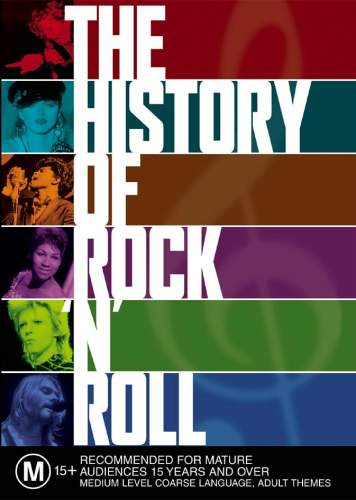The History of Rock 'N' Roll (1995) |
|
The History of Rock 'N' Roll (1995) |
|


|
| BUY IT |
| General | Extras | ||
| Category | Documentary | Main Menu Audio | |
| Rating |

|
||
| Year Of Production | 1995 | ||
| Running Time | 578:53 | ||
| RSDL / Flipper |
Dual Layered Multi Disc Set (5) |
Cast & Crew | |
| Start Up | Menu | ||
| Region Coding | 2,4,5 | Directed By | None Given |
|
Studio
Distributor |
Time Life Video & TV Warner Home Video |
Starring | Gary Busey |
| Case | ? | ||
| RPI | $89.95 | Music | None Given |
| Video | Audio | ||
| Pan & Scan/Full Frame | None | English Dolby Digital 5.1 (384Kb/s) | |
| Widescreen Aspect Ratio | 1.29:1 | ||
| 16x9 Enhancement | No | ||
| Video Format | 576i (PAL) | ||
| Original Aspect Ratio | 1.29:1 | Miscellaneous | |
| Jacket Pictures | No | ||
| Subtitles |
English German French Spanish Italian Dutch Polish Czech Hebrew Danish Arabic Greek Romanian Portuguese Hungarian Norwegian Bulgarian Swedish Icelandic Finnish English for the Hearing Impaired Italian for the Hearing Impaired German for the Hearing Impaired |
Smoking | Yes |
| Annoying Product Placement | No | ||
| Action In or After Credits | No | ||
I am a great lover of music of most types, flavours and genres. I was keen to review this series, which comes with an excellent reputation.
This series was produced in 1995 by Time Life and the basic format is a combination of archival performance footage, contemporary interviews with a huge selection of major music industry figures, especially the artists themselves, and some voiceover by narrator Gary Busey. The star is undoubtedly the archival footage which is excellent and includes a significant amount of well known and not so well known footage. It includes footage from concerts, television appearances and music videos. To my mind, the series lacks a little in terms of any detailed analysis but, considering the scope of the series in covering popular music for the mid-1950s to mid-1990s, that is probably not unexpected. The series is made up of 10 episodes each of vaguely an hour running time, however they do vary from sub-50 minutes to nearly 70 minutes. Each episode is written, produced and directed by different people, however, they are all done with a similar style. The show comes from an American point of view so only groups which made it in America are included. Also, the show ends with the rise of rap, so everything that has happened since then is not covered.
Interview subjects include (amongst many others): Bruce Springsteen, Bono, David Bowie, Sam Phillips (founder of Elvis's first record label, Sun Records), B B King, Little Richard, Brian May, Hank Ballard, Quincy Jones, Ray Charles, Jerry Garcia, Solomon Burke, Smokey Robinson, Steve Tyler, Eddie Van Halen, John Lydon, Dick Clark, Brian Wilson and The Everly Brothers. The interviews are interspersed with the musical footage and each section is generally only of soundbite length.
The series includes 10 episodes which are not strictly chronological and cover different facets of the history of rock music.. The episodes are:
Overall, this is a good quality series featuring excellent archival footage but which suffers from being out of date and lacking in any serious analysis except for one or two episodes.
The video quality is good.
The feature is presented in a 1.29:1 aspect ratio non 16x9 enhanced which is most likely the original aspect ratio.
The picture was reasonably clear and sharp throughout, with no evidence of low level noise, although this tended to vary, especially during the archival footage. The contemporary interviews included some grain. Its mid-1990s television origins mean that the clarity does not approach the sharpness of contemporary movies or even more modern television.
The colour was generally good during the interviews although I did notice some rainbow effects here and there. Obviously, much of the archival footage is in black and white. The archival footage is as clean as possible and comes across quite well.
From an artefact perspective, the interviews contained some minor macro-blocking and an occasional speck of white. The archival footage contains a bit of everything including tape tracking (especially during Elvis Costello's first television appearance), specks and flecks, edge enhancement, white lines and microphony. Considering the age of some of this footage, the artefacts are kept to a minimum.
There are subtitles in 20 languages including English plus English, Italian & German for the hearing impaired. The English subtitles were clear and easy to read.
The layer changes occur between the episodes.
| Sharpness | |
| Shadow Detail | |
| Colour | |
| Grain/Pixelization | |
| Film-To-Video Artefacts | |
| Film Artefacts | |
| Overall |
The audio quality is very good, especially considering the age of some of the material.
This DVDs contain an English Dolby Digital 5.1 soundtrack encoded at 384 Kb/s. To be fair, this is more of a 3.1 track as the surrounds are virtually not used. Generally speaking the sound is of good quality with all the music (even the very old material) coming across well. To my ears, the sound has not really been remixed for surround, so most of the music is stereo with bass added by the subwoofer and the dialogue comes from the centre speaker.
Dialogue was clear and easy to understand and there was no problem with audio sync.
The surround speakers were not used to any great effect.
The subwoofer was nicely integrated and added bass to the music as required.
| Dialogue | |
| Audio Sync | |
| Clicks/Pops/Dropouts | |
| Surround Channel Use | |
| Subwoofer | |
| Overall |
None!
The menu included stills, music and the ability to select scenes, languages and subtitles.
NOTE: To view non-R4 releases, your equipment needs to be multi-zone compatible and usually also NTSC compatible.
This set is the same in all regions. Buy whichever you can get cheaper.
The video quality is good.
The audio quality is very good but very front focused.
The disc has no extras.
| Video | |
| Audio | |
| Extras | |
| Plot | |
| Overall |
| Review Equipment | |
| DVD | Pioneer DV667A DVD-V DVD-A SACD, using Component output |
| Display | Sony FD Trinitron Wega KV-AR34M36 80cm. Calibrated with Digital Video Essentials (PAL). This display device is 16x9 capable. This display device has a maximum native resolution of 576i (PAL)/480i (NTSC). |
| Audio Decoder | Built in to amplifier/receiver. Calibrated with Video Essentials. |
| Amplification | Pioneer VSX-511 |
| Speakers | Bose 201 Direct Reflecting (Front), Phillips SB680V (Surround), Phillips MX731 (Center), Yamaha YST SW90 (Sub) |